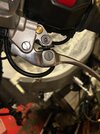Let’s think about that.
The clutch springs rate determine the line pressure necessary to achieve a given distance of spring compression, regardless of master and slave piston sizes or clutch lever geometry.
I say this in an exercise of clarity.
Regarding clutch levers myself, I perceive the VFR lever as easier to pull because it is less of a reach when adjusted so. Even though it crowds the pinky finger a bit, something that counters the full advantage of the shorter reach. The net effect is that I prefer using the VFR lever adjusted even closer than oem by way of a little grinding.

The issue to consider, does this set up push enough volume to disengage the clutch plates enough to avoid additional wear or at least wear of concern?
My data point for that is, I have ridden several ST1100 and ST1300 over 30,000-40,000 miles each with VFR levers that had been installed on bikes at 40,000 to 55,000 miles.
Another point. I bought a knockoff of stock lever. It had a shorter length lever that negated some of the comfort of having a shorter reach.
It had clutch safety switch actuation that limited the reach range.
It started wearing out unacceptably within 10,000 miles.


